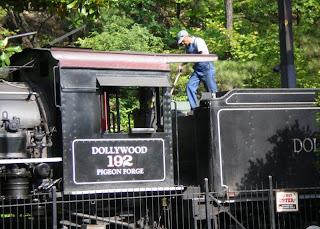
For some reason this reminded me of the lone caboose behind the single engine proudly displaying the slogan
"Go Big Train". In this case; What huge rail center? It's a Yellow Freight truck terminal now. Only one set of rails through the place, and it ends before the Hudson River. This shot is from the April trip to Altoona.
Maybrook Yard in Maybrook, NY (home of the photo above) once had the importance, if not more so, of today's huge Selkirk Yard outside of Albany. A lot of the freight traffic in and out of New England came through this town. Almost everything west of here except most New York Central RR traffic, funneled this way. Some freight caught the extensive carfloat system in the New York City area too. But, the main reason for this yard's existence was the
Poughkeepsie Bridge. This allowed freight to stay on land to cross the Hudson River above New York City and avoid the congested passenger lines that used the tunnels to Penn Station.
One reason I like the history of this place is the variety of lines that met here. We start with the
Erie, which later became the
Erie-Lackawanna. This road just screams class. From the gleaming Phoebe Snow passenger trains to the dusty antracite coal and cement regions, a main line across the midwest to Chicago and electric commuter trains in northern Jersey, this road had character.
Though the Phoebe Snow followed the old
DL&W main farther south, freight from the DL&W was important to the yard via a connection with the
Lehigh and Hudson River RR. This went over to a direct connection to Maybrook with the E-L merger but the road also connected with others like the
Pennsy,
Lehigh Valley,
Reading and
CNJ.
Alphabet Route trains from Chicago to New England also passed this way making the L&HR a key link in the chain. The previously mentioned NYC had a branch down to here because of all of the connections made.
Most noteably, a lot of home heating coal (anthracite anyway) bound for New England came through this yard. Most of my favorite "anthracite roads" connected here somehow. We have the connections mentioned already but by direct connection we had the
Lehigh and New England RR which was one of the main anthracite coal routes envisioned for the bridge. Then, there was the
New York, Ontario and Western which connected directly as well. Both of these roads naturally took quite a hit after coal lost favor for heating. The O&W had a little trade left with the Lehigh Valley as a Maybrook connection but their infrastructure and equipment was so old that shippers turned away eventually. The O&W finally ran out of time in the late '50's. The owners of the L&NE didn't wait for bankruptsy like the O&W. They pulled up the rails and sold the equipment while it was still had decent market value. They had a well run and maintained outfit right up to the end. Some pieces survive even today, but not around Maybrook, which they entered on an Erie branch.
I can't ignore the
Delaware and Hudson or
Susquehanna even though they missed this place by many miles. People love them, and with good reason. The D&H had a direct connection with Canada and the Suzy Q connected to New York City with their anthracite. They managed to bypass the Maybrook region and constitute exceptions I make for my model yard. They connected with nearly everyone I've mentioned, adding to the kaleidascope. The cool thing is that their present incarnations both use or have used the "Southern Tier" line - once the Erie main - which passes by the Campbell Hall commuter stop near the old Maybrook Yard. I think the Suzy Q still does since they bought a piece of the old L&HR. The D&H might not have used the line that far east.
The big name in town was of course the
New Haven. My favorite road. They were the guys with the Poughkeepsie bridge and the New England connections. Put this all together with the connecting roads in a single spot like Maybrook and the imagination goes a little wild. A few modelers I know incorporate Maybrook into their operations since the place was still alive before the bridge burned in the early '70's. The Maybrook line was just another domino that fell after the
Penn Central went down in flames. I of course like to do the "what if's" and envision a world in which the ICC butt out and allowed a collaborative effort that saved these operations from bankruptsy. We all know it wouldn't have worked but it would have been fun to model.
Once again, the tangents just kept showing up.
BC

 ST.Lawrence & Atlantic Train # 393. Yes we were in luck as at 21:45 (9:45pm) the crew got on
ST.Lawrence & Atlantic Train # 393. Yes we were in luck as at 21:45 (9:45pm) the crew got on ST.Lawrence & Atlantic Train # 393. Yes we were in luck as at 21:45 (9:45pm) the crew got on
ST.Lawrence & Atlantic Train # 393. Yes we were in luck as at 21:45 (9:45pm) the crew got on




